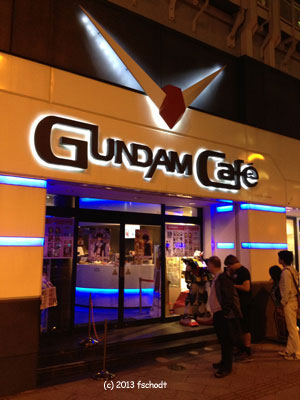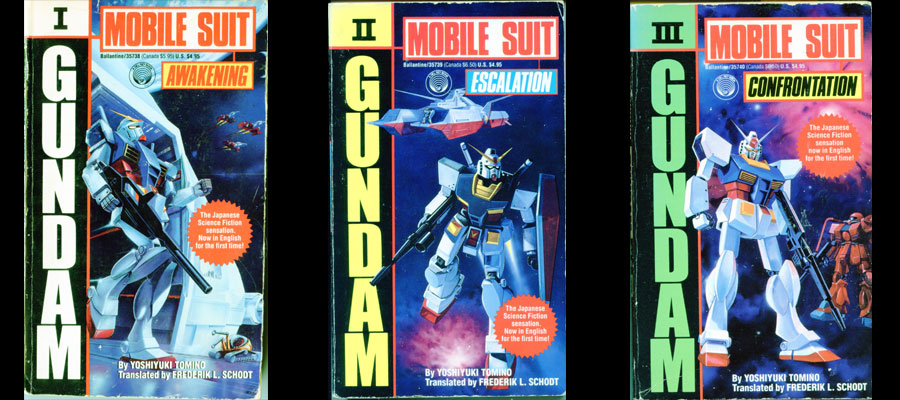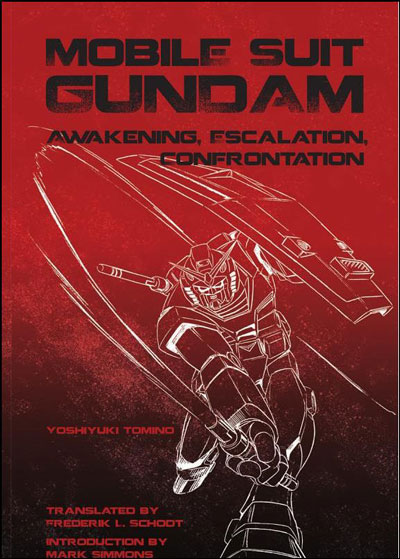MOBILE SUIT GUNDAM
『機動戦士ガンダム』 富野由悠季 (著) Translating Yoshiyuki Tomino's Mobile Suit Gundam novels.
Index



The Gundam TV animation series first appeared in 1979 in Japan, directed by Yoshiyuki Tomino. It soon became a blockbuster hit and a cultural phenomenon, rather like Star Wars, creating a vast universe of sequels and spin-offs, including theatrical feature films, music, robot toys, and other popular goods and doo-dads. Nearly ten years after the first animation series, Tomino went back and novelized his story, making it far more adult and filling in many of the critical details that had been glossed over or absent in the original TV animated series. He also created a story that diverges dramatically from the original (no spoiler info here!). Covers and inside illustrations for the Kadokawa "sneaker bunko" format paperback novels were rendered by none other than Haruhiko Mikimoto, the famous illustrator, character designer, and manga and animation artist. You can still buy these books on Amazon Japan, where they are always popular. Photos by moi show Yoshiyuki Tomino (left) directing an animated series at Sunrise, Inc., in the mid-1980s, and the Gundam cafe in Tokyo's Akihabara district in 2013.
Here's a synposis of the story:
In the world of the near future, an epic war rages between the Earth Federation and the rebel space colonies that call themselves the Principality of Zeon. The most fearsome weapons of the new era are the robotic vehicles known as mobile suits, armored giants with the firepower of battleships. The Federation has pinned its hopes for victory on its advanced mobile suit prototypes, but when a young cadet named Amuro Rey becomes the pilot of the Gundam mobile suit, he discovers that machines alone will not be the decisive factor in the conflict. For a new stage of human evolution is dawning, and the future--if humanity has a future--may well belong to the Newtypes.From the back cover of the translated English novel.
In January, 1988, I was contacted by Risa Kessler, vice president and director of creative development at Del Rey/ Ballantine/ Fawcett. They had just negotiated contracts to put out an English-language edition of Tomino's books, and given the nascent status of Japanese manga and anime in North America, it was at the time a fairly bold move. Kessler had kindly been given my name by Yoshiyuki Tomino. I think Kessler had also heard my name from Howard Roffman, at Lucasfilm, where I was doing quite a bit of interpreting at the time. When she asked me if I were interested in translating the series, I jumped at the chance. I had already served as Tomino's interpreter on his trips to the United States, and interviewed him in conjunction with my 1987 book on Japanese robotics; I admired his work, and was on very good terms with him. And this turned out to be very helpful, because the Gundam novels were not always easy to translate. This was partly because they were based on an animated series with which most of Japanese readers were already very familiar, but which many English-speakers knew nothing about. As far as I know, it was Tomino's first attempt at a novel, but he wanted it to stand on its own, to be a more serious, adult work, and one that could also give more depth to the original story. Whenever his phrasing was hard to decipher or convey properly, if I needed to, I could always ask him questions directly.
Del Rey was at the time one of the largest publishers of science fiction paperbacks in North America, and the company had already had great success in publishing mass market books such as the Star Wars novels, and, to a lesser extent, the Robotech novels. They were apparently hoping that Tomino's Gundam series might catch on in the same way. They kept the same basic Japanese configuration of three separate paperback volumes, retitling them to "Awakening," "Escalation," and "Confrontation." There was talk of getting Syd Mead to do the covers, but that apparently didn't work out. I personally recommended using the Japanese illustrator Yoshiyuki Takani, who is famous in Japan for his Gundam and other robot/mecha illustrations, but that didn't work out, either. The poor artist ultimately employed alas doesn't even get a credit in the books. Unlike the Japanese originals, there are no illustrations included, but there is a map showing the layout of the near-Earth Gundam universe in U.C. 0079, with Lagrange Points and Sides, which is very helpful to newcomers trying to figure out the layout of the complicated story. Among fans, there was also some controversy over the spellings I used for characters and place names. At the time,there was no standard English phoneticization of Tomino's names, and for reference some fans were using random and not accurately romanized spellings found on the box tops of plastic model kits or fan magazines sold in Japan, or spellings that they came up with themselves. I tried to hew closely to the original Japanese names, but this upset some North American fans who had already developed an attachment to spellings that they preferred. Some, for example, wanted to spell the character シャー as Char, but I spelled it as Sha, which is far closer to the Japanese (Even though the name may have its roots in "Charles Aznavour"). Similarly, some wanted to spell ジオン as Zion, or Jion, or Xeon, but I chose to spell it as Zeon, to avoid any religious connotations, which I thought Tomino did not intend. It might seem odd today, given the current international appeal of the Gundam franchise, but in 1988 I wasn't even completely sure how to translate the title. Should it really be "Mobile Suit Gundam", or "The Gundam Mobile Suit"? Although the former is firmly accepted today in English and seems obvious, for people seeing the title for the first time, there can be a certain illogic to it in English.

Ultimately, the Del Rey edition of Gundam sold what I estimate to be nearly 75,000 copies--a number big enough to make most publishers drool, if not faint, especially given that there was little marketing effort made. But Del Rey was expecting success on a much larger scale. After a few years, Del Rey let the books go out of print. After that, I wrote the editors nearly every year, encouraging them to reprint the books, and telling them of the growing market for Japanese anime and the increasing number of Gundam anime fans. I had no luck, and even received one letter stating that in Del Rey's opinion the anime/manga fan scene was not growing at all in the 'States. Finally, after many years, in 2000 I was able to get the rights back to my translation, and I offered the book to Stone Bridge Press, a small independent publisher in Berkeley, California. Just trivia information for Gundam fans, but Del Rey had originally acquired the rights to translate the original Gundam novels, as well as the Z Gundam series, and asked me to translate all of them. In 1988, I said that I couldn't commit to all eight because it would take years and if the books didn't sell I would starve to death. I suggested doing the first Gundam series and seeing how it was received, then committing to the second series. Unfortunately, we never got to that stage.

In May, 2004, the intrepid Stone Bridge Press finally issued Yoshiyuki Tomino's Mobile Suit Gundam trilogy of novels, combining all three books in a new giant single-volume format. Over 480 pages, it contained not only the UC 0079 Gundam space map, but line art illustrations of the main characters and mecha from anime production design sketches. In the over fifteen years since I first translated the series, the Gundam universe had been vastly expanded and developed commercially in both Japan and abroad, so I was also able to go back and use a list of officially determined English spellings for characters and mecha and update the text. It's fun to see the official list today, because it incorporates some of the spellings I originally used, such as Zeon, but retains others that had become popular with fans, such as Sha. The new format issue allowed me to update my original "Word from the Translator" and--much more important--it allowed us to incorporate a new introduction by U.S. Gundam expert and authority Mark Simmons (who has gone on to become a wonderful artist).
Here are the book specs. Occasionally, you can still find copies of this old edition on Amazon,and Barnes and Noble.
Information:
Stone Bridge Press
2004-04-01
ISBN-10: 1880656868
ISBN-13: 978-1880656860
Paperback, 8.9 x 5.9 x 1", 480 pp
After a few years, the contract with the Japanese rights-holders expired, and the novel again went out of print. Scarcity creates demand, I guess, and while out of print it was amazing to see how demand for the book shot up. Fans were apparently bidding on it, so at one point on Amazon vendors were asking for nearly $1500.00 a copy. I hope that no one ever paid that much for the book, because it's now available again. Why did the book go out of print? Mainly because the Gundam property is a very complicated one, and negotiations to extend the publication rights proceeded at the speed of ancient sludge, mired in Japanese bureaucracy and unintentional obfuscation. Anything related to the Gundam novels today involves a complicated chain of rights management that includes not only Yoshiyuki Tomino, but the animation production company Sunrise, publishers Kadokawa, Bandai, the Sotsu Agency, and the Tohan Corporation, so it can take eons to get replies to even the most basic queries. The Sunrise animation studio, I might add, is now under the umbrella of the Bandai-Namco holding company.
Here are the new book specs. It has the same illustrations as the 2004 edition, but a spiffy new cover and more pages. It's slightly more compact in size, which makes it easier to hold. Click the cover to see a larger image. Design is by the talented Linda Ronan, of Stone Bridge Press. We're hoping to be able to keep this edition in print for a long time, so if you're a Gundam fan, please spread the word!
Information:
Stone Bridge Press
2nd ed. 2012-04-03
ISBN-10: 1611720052
ISBN-13: 978-1611720051
Paperback, 8.4 x 5.4 x 1.3", 520 pp
--- GRAB A COPY!
...[T]he characters are deeply layered, with complex motivations and beliefs. Jealosy, family rivalry, sex, lust for power, suspicion, fear, and a host of other all-too-human attributes influence the flow of the narrative, with the fog of war confusing the judgements of both sides.... this book is ultimately a page-turner.... Andrew J. Weber, in The Asian Reporter, V14, #40 (September 28, 2004), p. 11.
"Mobile Suit Gundam was and remains a captivating epic saga ... "Gundam viewers can enjoy a rendition that departs significantly from its animated counterpart ... Highly recommended, especially for "Gundam anime fans." Library Bookwatch
"There is enough new stuff here to keep even a hardened fan engaged. ...Even for a casual read, the novel remains true to the spirit of the series, while remaining fresh enough to be exciting.AnimeFringe
"Gundam viewers can enjoy a rendition that departs significantly from its animated counterpart...yet retains the visionary science fiction themes of exploration, change, and the struggle to adapt and survive in a technology-driven era scarred with conflict. —Midwest Book Review
The novels allow Tomino to explore the world of Mobile Suit Gundam in greater depth than either the anime or the manga; some of the specifics about the characters and their motivations can be found nowhere else.Experiments in Manga, 2013-09-20.




